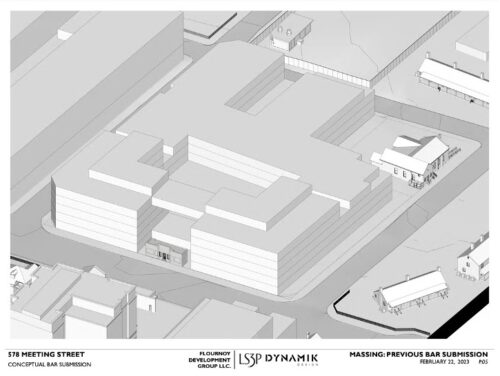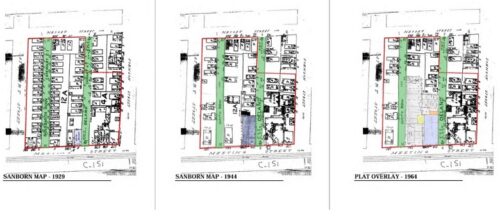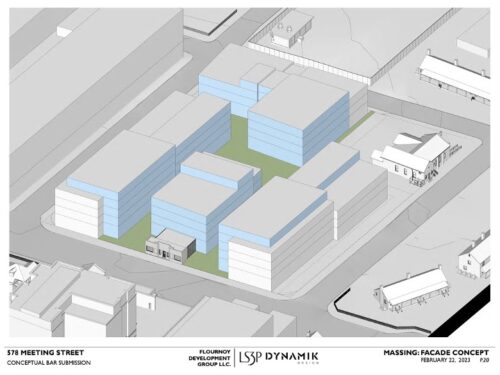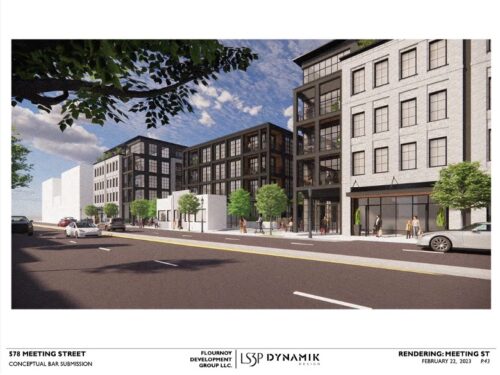 Menu
Menu
Posted: March 6, 2023
-by Justin Schwebler, Properties Manager and BAR-L Liaison, February 27, 2023
How can developers of new large-format projects use the past as inspiration in their designs?
On February 22, 2023 the Board of Architectural Review – Large, unanimously voted for Conceptual Approval of a new 200 unit, multi-family development, at 578 Meeting St, the former location of the Regis Milk Plant. The owners of the project, Flournoy Development Group, and architects Dynamik Designs and LS3P, have submitted 2 previous designs for the site that were previously denied by the BAR and opposed by Historic Charleston Foundation.
The previous designs were overly massive and covered almost an entire city block under the building footprint. The designs were driven by the need to incorporate an internal parking garage for the apartments. Historic Charleston Foundation opposed these previous applications because of the overwhelming massing and footprints of the buildings, and also because the designs failed to successfully incorporate the single story façade of the historic Regis Milk Factory that has been preserved on the site.

Figure 1 Massing Study of Previously Denied Application
When faced with a denial from the BAR the design team is asked to restudy the project and come up with a new design that incorporates the comments and criticism the board and city staff, or they can file an appeal of the BAR decision with the District Court. Instead of filing an appeal and trying to force the project through by court decision as other developers have done, subverting the role of the BAR, this development team decided to take a fresh look at the project.
The team went back to the drawing board, taking the BAR and preservation organization’s comments into consideration to help drive a new design for their development that was more compatible with the character of Charleston’s urban fabric.
The greatest limitation to their design, which has been a consistent problem for all major developments, was how to incorporate the huge parking garage. The owners and designers made the costly and ambitious plan to excavate the site in order to bury the parking under the development. This gave them the ability to then design buildings free from the constraints of hiding a parking garage.
So how did they use the past to inspire their new designs?

Figure 2 Sanborn Fire Insurance Maps of the 578 project site showing the two historic alleyways.
In order to create a new site plan, the architects went back to historic fire insurance maps from the early 20th century to see what the site looked like in the past. They noticed that prior to the Regis Milk Factory the block was actually divided by two alleyways (Goldsmith Row and Oeland), that were lined by small residential cottages. The alleys existed until 1964, even after the Regis Milk Building was constructed, which provided a unique opportunity. The team decided to reestablish these alleyways as a way to break up the massing of the new buildings and help revive a long lost part of Charleston’s historic street grid.

Figure 3 Approved massing study that incorporates the historic alleyways on either side of the Regis Milk Building.
We were excited to see the updated renderings when the project team brought them to HCF several weeks before submission to the BAR. It was clear that the team took the BAR’s recommendations to heart, and they looked for novel ways to rethink the program of their development in order to create a much stronger design. Reestablishing the historic alleyways has helped to break up the massing of the apartment buildings, and has helped to enforce greater relief for the Regis Milk building. This allows the Regis building to retain its place of prominence on this block of Meeting St, without being overwhelmed by the massing of the new construction.
While we still have some concerns over the architectural direction of the project, we felt that those issues could be handled at the Preliminary Review level. Historic Charleston Foundation was happy to lend our support for the new design, especially after seeing the lengths the team went to in order to break up the massing of their buildings, and using the historic street grid as a creative inspiration for the organization of the site plan.

This project should serve as a precedent for future developments on how to successfully use the character of Charleston’s urban fabric to inspire good design that is compatible with our city’s architectural heritage.
One such development on the horizon is the Union Pier Terminal. The Union Pier development must not become the next cookie-cutter apartment building or office building development. The development of Union Pier deserves a thoughtful approach, with input from the community. The pace of the Union Pier Terminal redevelopment project is alarming and this project is too important to rush. We encourage you to visit MakeItCharleston.com to learn more about Union Pier Terminal and to stay engaged. Read more about MakeItCharleston.com HERE and visit the website HERE.
It is still too much mass. Design look to ‘cookie cutter!’ Office building. Why ? Why? Can’t be more sympathetic to downtown/ old style ‘look’….
While I’m glad to read about this step in the right direction, I continue to be frustrated and perplexed by these renderings of modern architecture. This continues to happen over and over again with developers and there is no reason for it. I studied Architecture and Interior Design and these buildings could be built in classical Georgian or Federalist style. Why isn’t this being required by the BAR and HCF? Large buildings can be designed to look old. This is a no-brainer especially in Charleston!